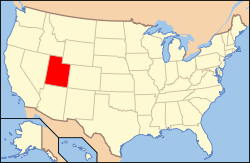Garland, UT
| Garland, Utah | |
|---|---|
| City | |

The Garland Tabernacle, an early Latter-day Saint meetinghouse
|
|
| Motto: "A Family Community" | |
 Location in Box Elder County and the state of Utah |
|
 Location of Utah in the United States |
|
| Coordinates: 41°43′58″N 112°9′42″W / 41.73278°N 112.16167°WCoordinates: 41°43′58″N 112°9′42″W / 41.73278°N 112.16167°W | |
| Country | United States |
| State | Utah |
| County | Box Elder |
| Settled | 1890 |
| Named for | William Garland |
| Area | |
| • Total | 1.9 sq mi (4.9 km2) |
| • Land | 1.9 sq mi (4.9 km2) |
| • Water | 0.0 sq mi (0.0 km2) |
| Elevation | 4,340 ft (1,323 m) |
| Population (2012 est.) | |
| • Total | 2,360 |
| • Density | 1,250/sq mi (482.8/km2) |
| Time zone | MST (UTC-7) |
| • Summer (DST) | MDT (UTC-6) |
| ZIP code | 84312 |
| Area code(s) | 435 |
| FIPS code | 49-28150 |
| GNIS feature ID | 1428146 |
| Website | www |
Garland is a city in Box Elder County, Utah, United States. The population was 2,400 at the 2010 census.
Garland was originally named "Sunset" and settled in 1890. The first settler was David E. Manning.
It was a company town and was renamed after William Garland, the contractor who built the Utah Sugar Company factory at the location, completed in 1903. The company donated land to the LDS Church for a "ward chapel and amusement hall" and also built 14 homes, a hotel, and other buildings. The town had a general store, a bank, a post office, and a newspaper named The Garland Globe in 1906. By the 1920s there were other merchants, a flour mill, a Carnegie library, and a high school.
Garland is located in eastern Box Elder County in the Bear River Valley. It is bordered by the city of Tremonton to the south. Interstate 15 passes to the west of Garland, with the closest access from Exit 381, 2.5 miles (4.0 km) southwest of the center of town.
According to the United States Census Bureau, the city has a total area of 1.9 square miles (4.9 km2), all of it land.
As of the census of 2000, there were 1,943 people, 588 households, and 476 families residing in the city. The population density was 1,097.8 people per square mile (423.8/km²). There were 621 housing units at an average density of 350.9 per square mile (135.5/km²). The racial makeup of the city was 88.99% White, 0.41% Native American, 3.14% Asian, 0.05% Pacific Islander, 5.46% from other races, and 1.96% from two or more races. Hispanic or Latino of any race were 7.87% of the population.
...
Wikipedia
